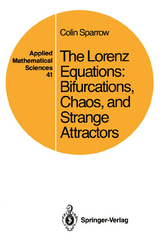The Lorenz Equations
Springer-Verlag New York Inc.
978-0-387-90775-8 (ISBN)
1. Introduction and Simple Properties.- 1.1. Introduction.- 1.2. Chaotic Ordinary Differential Equations.- 1.3. Our Approach to the Lorenz Equations.- 1.4. Simple Properties of the Lorenz Equations.- 2. Homoclinic Explosions: The First Homoclinic Explosion.- 2.1. Existence of a Homoclinic Orbit.- 2.2. The Bifurcation Associated with a Homoclinic Orbit.- 2.3. Summary and Some General Definitions.- 3. Preturbulence, Strange Attractors and Geometric Models.- 3.1. Periodic Orbits for the Hopf Bifurcation.- 3.2. Preturbulence and Return Maps.- 3.3. Strange Attractor and Homoclinic Explosions.- 3.4. Geometric Models of the Lorenz Equations.- 3.5. Summary.- 4. Period Doubling and Stable Orbits.- 4.1. Three Bifurcations Involving Periodic Orbits.- 4.2. 99.524 < r < 100.795. The x2y Period Doubling Window.- 4.3. 145 < r < 166. The x2y2 Period Doubling Window.- 4.4. Intermittent Chaos.- 4.5. 214.364 < r< ?. The Final xy Period Doubling Window.- 4.6. Noisy Periodicity.- 4.7. Summary.- 5. From Strange Attractor to Period Doubling.- 5.1. Hooked Return Maps.- 5.2. Numerical Experiments.- 5.3. Development of Return Maps as r Increases: Homoclinic Explosions and Period Doubling.- 5.4. Numerical Experiments on Periodic Orbits.- 5.5. Period Doubling and One-Dimensional Maps.- 5.6. Global Approach and Some Conjectures.- 5.7. Summary.- 6. Symbolic Description of Orbits: The Stable Manifolds of C1 and C2.- 6.1. The Maxima-in-z Method.- 6.2. Symbolic Descriptions from the Stable Manifolds of C1 and C2.- 6.3. Summary.- 7. Large r.- 7.1. The Averaged Equations.- 7.2. Analysis and Interpretation of the Averaged Equations.- 7.3. Anomalous Periodic Orbits for Small b and Large r.- 7.4. Summary.- 8. Small b.- 8.1. Twisting Around the z-Axis.- 8.2. Homoclinic Explosions with Extra Twists.- 8.3. Periodic Orbits Without Extra Twisting Around the z-Axis.- 8.4. Heteroclinic Orbits Between C1 and C2.- 8.5.Heteroclinic Bifurcations.- 8.6. General Behaviour When b = 0.25.- 8.7. Summary.- 9. Other Approaches, Other Systems, Summary and Afterword.- 9.1. Summary of Predicted Bifurcations for Varying Parameters ?, b and r.- 9.2. Other Approaches.- 9.3. Extensions of the Lorenz System.- 9.4. Afterword — A Personal View.- Appendix A. Definitions.- Appendix B. Derivation of the Lorenz Equations from the Motion of a Laboratory Water Wheel.- Appendix C. Boundedness of the Lorenz Equations.- Appendix D. Homoclinic Explosions.- Appendix E. Numerical Methods for Studying Return Maps and for Locating Periodic Orbits.- Appendix F. Computational Difficulties Involved in Calculating Trajectories which Pass Close to the Origin.- Appendix G. Geometric Models of the Lorenz Equations.- Appendix H. One-Dimensional Maps from Successive Local Maxima in z.- Appendix I. Numerically Computed Values of k(r) for ? = 10 and b = 8/3.- Appendix J. Sequences of Homoclinic Explosions.- Appendix K. Large r; the Formulae.
| Reihe/Serie | Applied Mathematical Sciences ; 41 |
|---|---|
| Zusatzinfo | XII, 270 p. |
| Verlagsort | New York, NY |
| Sprache | englisch |
| Maße | 155 x 235 mm |
| Themenwelt | Mathematik / Informatik ► Informatik ► Theorie / Studium |
| Mathematik / Informatik ► Mathematik ► Analysis | |
| Naturwissenschaften ► Physik / Astronomie ► Mechanik | |
| Naturwissenschaften ► Physik / Astronomie ► Thermodynamik | |
| ISBN-10 | 0-387-90775-0 / 0387907750 |
| ISBN-13 | 978-0-387-90775-8 / 9780387907758 |
| Zustand | Neuware |
| Informationen gemäß Produktsicherheitsverordnung (GPSR) | |
| Haben Sie eine Frage zum Produkt? |
aus dem Bereich




